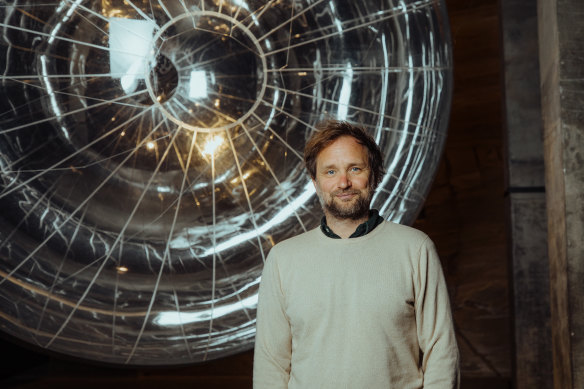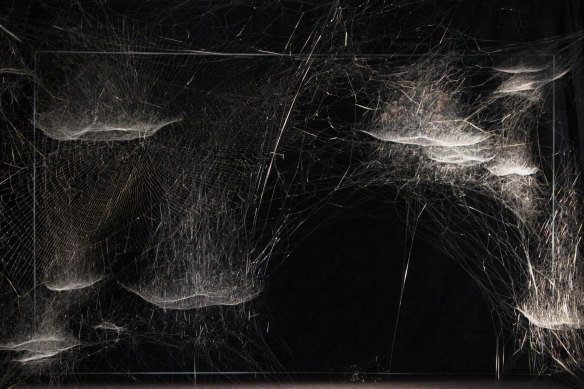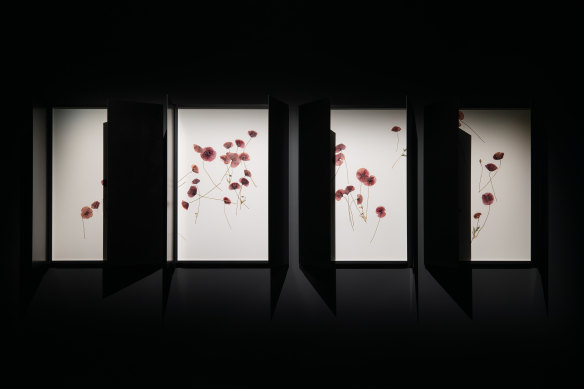The first thing you see is a flash of light, and then your eyes begin to adjust to the darkness that promises to follow you for the next hour or more. “Move slow,” warns Tomás Saraceno with a laugh. The artist had cautioned me a few days earlier that his new exhibition, Oceans of Air, is not one you can rush through.
Held over 12 rooms in the lower levels of Mona – Hobart’s Museum of Old and New Art – Saraceno plays with scale, sound and light to explore surprising connections on both a micro and macro level.
Artist Tomás Saraceno whose exhibition Oceans of Air is showing at Hobart’s Museum of Old and New Art.Credit:Jesse Hunniford
His fascination with connections and relationships rings out not only through every piece in the exhibition but in the way they fit together. The first work you encounter in the main space is Particular Matter(s), which features a beam of light shone through a darkened room, highlighting the dust in the air which dances and floats in front of you.
Nearby is Our Place in the Vast and Ancient Sky, a single image speckled with dots and a faint cloud. As the title promises, it’s a view of the sky, a single line in the middle tracking the path of a satellite – and its visual similarity to the neighbouring dust is impossible to ignore.
I look at the normally invisible dust highlighted in Particular Matter(s) and think, oh, I’m breathing this in, a fact brought home by the following work, We Do Not All Breathe the Same Air, which tracks air pollution around Australia. Tucked away on a nearby wall is Billions of Years Printed with Pollution, where images of the cosmos have been created using ink made of black carbon PM2.5, on paper so delicate it flutters on the breeze.
There are connecting lines everywhere, mostly figurative, but in the case of Webs of At-tent(s)ion, literal. For these, Saraceno works with “social spiders” – spiders that are happy to be around other species and even build upon their webs. The result is a series of grand, intricate worlds made of spider silk, preserved in glass cabinets. Saraceno leaves things up to the spiders – he simply provides a metal frame and then “we invite them” he says. “Because the frame is open and there is no glass they come and go.”
Webs of At-tent(s)ion by Tomás Saraceno as part of the Oceans of Air exhibition.Credit:Tomás Saraceno
Mona senior curator Emma Pike points to how the spider web works function as a conceptual stronghold for the entire exhibition. “They’re talking about the interconnectedness of things – about interspecies collaborations, about what we might be able to learn if we listen to each other and other species more carefully.”
Oceans of Air explores the relationship between spiders and one another, between sound and visuals, between pollution and nature, even between art and audience.
In one room, a series of pressed poppies collected from near his Berlin studio – where the ground is contaminated from the building’s previous life as a factory – are displayed on one wall flanked by shutters. Visitors can choose to close the shutters or leave them open. The more the poppies are exposed to the air, the more their colour will fade across the coming months – but hidden away, protected, we have no opportunity to enjoy their colour at all.
Saraceno – and by extension his work – occupies a fascinating space between art, science and even spirituality, all of which come to a head in a room featuring a cabinet filled with books and documents that move from the practice of spider divination – where spiders are used to answer binary questions – through to papers and images detailing Saraceno’s work with scientific institutions, including breakthroughs in mapping webs and creating music out of spider webs.
Silent Spring, 18052021, 2022, Tomás SaracenoCredit:Mona/Jesse Hunniford
Both of these accomplishments are on display in the surrounding rooms. One features a spider web slowly being parsed by a red laser, a scanning process Saraceno explains that he developed over three years. In the other, long strands of spider silk, each end tethered to opposing walls, float in the air, which fills with an eerie soundtrack generated by their movement.
In the room between, behind the cabinet is a round table surrounded by a curtain. Overhead is a small spiderweb encased in glass, and neatly laid out are a series of cards developed by Saraceno for arachnomancy, a practice related to spider divination. For the exhibition, five tarot readers have been trained to practice this art, and will be doing readings for visitors who book in.
I have a theory about the final room. It’s more whimsical than what has come before – there are floating orbs, and mobiles, including one that looks to be defying gravity as it floats upside down. Silhouettes and shadowy animations play out around us. To me, it feels like a return to the beginning, as though we are now inside the beam of light – here we are the specks of dust floating in the air, the walls between art and the “real world” freshly broken down.
Tomás Saraceno’s Oceans of Air opens at MONA on December 17 and runs until July 24, 2023.
A cultural guide to going out and loving your city. Sign up to our Culture Fix newsletter here.
Most Viewed in Culture
From our partners
Source: Read Full Article


